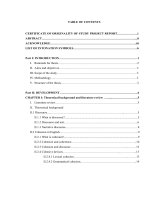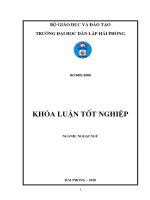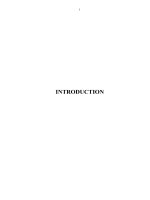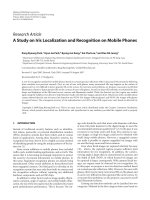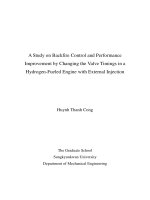A study on body weight and benefit cost ratio of weaned kids of sirohi goat fed with different levels of concentrates
Bạn đang xem bản rút gọn của tài liệu. Xem và tải ngay bản đầy đủ của tài liệu tại đây (163.63 KB, 6 trang )
Int.J.Curr.Microbiol.App.Sci (2020) 9(3): 383-388
International Journal of Current Microbiology and Applied Sciences
ISSN: 2319-7706 Volume 9 Number 3 (2020)
Journal homepage:
Original Research Article
/>
A Study on Body Weight and Benefit Cost Ratio of Weaned Kids of Sirohi
Goat Fed with Different Levels of Concentrates
Hanuman Lal Nehra1*, Athar Uddin1, Vinod Bhateshwar2 and Hitesh Muwal3
1
Department of Livestock Production Management, Sri Karan Narendra Agriculture
University, Jobner (Raj.) India
2
Department of Animal Husbandry & Dairying, Banaras Hindu University,
Varanasi (U.P.) India
3
Maharana Pratap University of Agriculture and Technology, Udaipur (Raj.) India
*Corresponding author
ABSTRACT
Keywords
Concentrates, Body
weight, Benefit cost
ratio and Sirohi goat
kids
Article Info
Accepted:
05 February 2020
Available Online:
10 March 2020
The present research work was carried out to study the effect of concentrate feeding on
body weight and benefit cost ratio of weaned kids of Sirohi goat. Twenty four kids of
Sirohi breed between 3-4 months age were randomly selected on the basis of uniform body
weight, age and divided into 3 groups of 8 kids each at the goat farm of S.K.N. College of
Agriculture, Jobner. Group T 1 served as control supplemented with 50 g concentrate per
kid per day for 3 months. Group T 2 (treatment) supplemented with 50, 100 and 150 g
concentrate and T3 (treatment) with 100, 150 and 200 g concentrate per head per day for
1st, 2nd and 3rd month, respectively. Other management practices were similar for each
group. Fodder of khejri loom was offered ad-libitum to all groups. Body weight of kids
was recorded weekly. Group T 3 fed with more quantity of concentrate achieved the highest
(85.77 g/day) average weekly weight gain followed by T 2 (69.22 g/day) and control group
T1 (61.33 g/day). Maximum average total weight gain per kid was observed in group T 3
(7.72 kg) followed by T 2 (6.23 kg) and least was found in T 1 (5.52 kg). It is concluded
from the results that there was significant increase in weekly and monthly weight gain
(P≤0.01) of kids supplemented with higher quantity of concentrate in diet. Thus from
above findings it can be concluded that T 2 and T3 treatments showed significantly
improved body weight in Sirohi kids and higher level (T 3) was relatively the best level in
terms of both biological and economical returns.
and dairy farming are not economical. Goat
plays an important role in generating
employment in rural areas. Being small in
size, they do not require any large
management skills and can be easily handled
and managed by women and children. Goats
can survive in areas with low quality
Introduction
Goats have multifaceted utility as a livestock
species and play significant role in rural
economy. Rearing of goats is very useful for
small and marginal farmers and landless
labourers especially in the areas, where crops
383
Int.J.Curr.Microbiol.App.Sci (2020) 9(3): 383-388
vegetation. In India, goats are mainly fed on
crop residues, green fodder, top feeds and
non-conventional feed resources.
systems and needs to be evaluated. The
quality and quantity of concentrate fed to
growing kids has got very much importance
for their maintenance and weight gain. Many
farmers in India rear goats for the purpose of
meat production and for them the growth is
most valuable.
Goat meat has no religious taboo and the
market for it is well established. They are
traditionally raised by poverty stricken village
people in a secondary system of grazing on
harvested fellow land, along the road and
canal sides, community pasture land without
any supplementation.
Supplementation of concentrate is required
for faster weight gains, but it should also be
economical. So it is necessary to decide the
adequate level of concentrate for faster
growth rate.
For the poor farmers who are unable to
maintain large ruminants, goat justifies its
designation as “the poor man‟s cow”. Under
the changing agro-geo-climatic conditions
and depleting resources for livelihood, the
goat has tremendous potential to be projected
as the „Future Animal‟ for rural prosperity. As
per 19th livestock census 2012, the Goat
population of India is 135.17 million, which is
26.40% of total livestock population of the
country. The goat population reduced by 3.82
percent in 2012 over 2007 census, India rank
2nd in total goat meat production and average
yield of meat of indigenous goat is 10.74
kg/animal (Annual report 2015-2016,
Department of Animal Husbandry ,Dairy and
Fisheries, GOI).
Most of the small farmers rear goats by
keeping animals free for grazing on local
grass, bushes, tree leaves and kitchen waste
only. These are deficient mainly in protein
and energy. For obtaining optimum growth of
kids, it is essential to supplement required
quantity of concentrate.
The kids after weaning suffers with the
deficiency of nutrients which hamper their
growth and their available feeds need
supplementation of concentrate to increase the
growth rate and economic returns.
Materials and Methods
Supplementation of concentrates is important
for growth and productivity of goats
(Kochapakdee et al., 1994). By feeding good
quality concentrate
we
can
satisfy
requirement of both protein and energy.
Increasing concentrate levels in kid diet
results in increased live weight, as well as
carcass weight (Ryan et al., 2007).
Place of work
The experiment was conducted at goat farm,
S.K.N. college of Agriculture, S.K.N.
Agriculture University Jobner, District Jaipur,
(Rajasthan, India).
Selection of experimental animals and
design
However, reports on the nutrient requirements
are scanty and very little information is
available particularly on the contribution of
dietary protein and energy to the performance
of growing kids under farm conditions and the
cost benefit of feeding additional concentrates
has not been fully explored in goat-production
Twenty four Sirohi goat kids of either sex
having approximately uniform body weight
and age group (4 months) were selected.
These kids were divided into three equal
groups consisting of eight kids in each group
and the study was carried out for a period of
384
Int.J.Curr.Microbiol.App.Sci (2020) 9(3): 383-388
thirteen weeks. The experiment was
conducted using randomized block design.
Statistical analysis
Statistical analysis was carried out by
standard statistical methods RBD and the
calculation of ANOVA was done. This
formula was given by Fisher and Yates
(1950). Superscripts are used for significantly
difference in means by DMRT method.
Duncan‟s new multiple range test (DMRT) is
a multiple comparison procedure developed
by David B. Duncan in 1955.
Housing and management of experimental
animals
Similar housing and managemental facilities
were provided to all the groups. Animals were
penned in well-ventilated enclosures for the
experiment.
Feeding of experimental animals
Results and Discussion
The concentrate mixture in pelleted form was
obtained from local market Concentrate and
roughages were fed separately to each kid in
all treatment groups. The concentrate was fed
once in a day at 10:00 am. Whereas, the
roughage (khejri loom) was offered at 10:30
am and 4:00 pm to all treatment groups. Adlibitum clean drinking water was available
round the clock to all treatment groups.
Body weight
Table 3 shows the total gain in body weight
5.52, 6.23 and 7.70 kg for groups T1, T2 and
T3, respectively. There was significant
difference (P≤0.01) between three treatments.
The total gain in weight of kids from group T3
was significantly (P≤0.01) higher than kids
from group T1 and T2. However, total gain in
weight of kids from group T2 was
significantly (P≤0.01) higher than that of T1.
Guru et al., (2004) observed that at the end of
the experiment kids with higher levels of
concentrate supplementation tended to
maintain heavier body weights. Anil Kumar et
al., (2009) also recorded at the end of
experiment that the body weight of the ewes
which were fed higher amount of concentrates
was significantly heavier than ewes receiving
less amount of concentrates. The results
obtained in present trial were in agreement
with these findings.
Body weight
All the experimental kids were weighed early
in the morning, before offering the feed, at
weekly intervals upto 13 weeks from the
commencement (4 months of age) of the
experiment. Weighing was carried out by
digital weighing balance/electronic. The
experimental kids were weighed individually
at the start of the experiment and at weekly
intervals thereafter, up to 90 days on
weighing balance.
Benefit cost ratio of concentrate feeding
Benefit cost ratio
It was calculated on the basis of additional
cost involved in supplementation of
concentrate and value of additional weight
gain. The cost of additional concentrate
mixture was calculated as per the prevailing
market rates. The cost of additional weight
gain was also calculated as per the prevailing
rate of kids on kg live weight basis.
The input- output relationship is presented in
Table 4. Total concentrate intake for groups
T1, T2 and T3 was 4.30, 8.50 and 12.50 kg/kid,
respectively, during a period of three months
of feeding concentrate. It was observed that
the cost incurred was Rs.86.00, 170.00 and
250 per kid for groups, T1, T2 and T3,
385
Int.J.Curr.Microbiol.App.Sci (2020) 9(3): 383-388
respectively, indicating higher cost of feeding
for group T3 than T2 and T1. Total live weight
achieved at the end of experiment was 16.57,
17.31 and 18.73 kg/kid for T1, T2 and T3,
respectively. Additional weight gain for T2
and T3 was 0.74 and 2.16 kg, respectively.
Additional Income realizable from total gain
in weight during trial period for treatment
groups T2 and T3 was Rs. 222.00 and 648.00
per kid and additional profit from total weight
gained was Rs.138.00 and 484.00 rupees,
respectively. Thus, the extra profit of
Rs.346.00 per kid can be obtained due to
feeding 100, 150 and 200 g in T3, followed by
Rs 138.00 due to feeding of 50, 100 and 150 g
in T2 than feeding of 50 g concentrate in
control group.
Table.1 Distribution of experimental Sirohi goat kids
Treatments No. of Animals Average body weight (in kg)
08
11.05±0.80
T1
08
11.08±0.71
T2
08
11.03±0.78
T3
Table.1 Feeding schedule of weaned kids of Sirohi goat
Experimental period
(days)
T1
T2
T3
Concentrate supplementation gram/head/day
50
50
100
50
100
150
0-30
31-60
50
61-90
150
200
Table.2 Chemical composition (%DM Basis) of concentrate mixture
S.N.
1.
2.
3.
4.
5.
Nutrients
Total digestible nutrient (TDN)
Crude protein (CP)
Crude fibre (CF)
Common salt (CS)
Mineral mixture(M.M.)
Percentage
75%
18%
10%
1.0%
2.0%
Table.3 Average total weight gain (kg/week) of Sirohi kids in different groups
Initial body weight (kg)
Final Body Weight (kg)
Total gain in weight
Weight gain/day/kid
T1 (Mean±SE) T2 (Mean±SE) T3 (Mean±SE)
11.05
11.08
11.03
16.57
17.31
18.73
c
b
5.52 ±0.14
6.23 ±0.20
7.70a±0.24
0.061b±0.04
0.069b±0.03
0.085a±0.01
386
Int.J.Curr.Microbiol.App.Sci (2020) 9(3): 383-388
Table.4 Benefit cost ratio of Sirohi goat kids
Attributes
Initial body weight(kg)
Final Body Weight(kg)
ADG(gm)
Total concentrate intake (kg/kid)
Cost of concentrate/kid (Rs) 20/kg
Additional concentrate ration cost
Additional weight gain (kg)
Cost of live weight @ Rs 300/-per kg
Gross Benefit (Rs)
Net Benefit (Rs)
Extra Benefit (Rs)
T1
11.05
16.57
61.33
4.30
86
4971
-
Similar observations were reported by Guru
et al., (2004) who concluded that of all levels
of supplementation of concentrate for feeding
of growing kids, higher level (450g/h/d) was
relatively the best level in terms of both
biological and economical returns. Haddad
(2005) also observed that higher concentrate
diets had reduced production costs compared
to lower concentrate diets fed to kids. The
results are in agreement with Jabbar and
Anjum (2008) who recorded that higher
concentrate level in diet (forage to
concentrate ratio of 25:75) most appropriate
for economical mutton production from Lohi
lambs.
T2
11.08
17.31
69.22
8.50
170
84
0.74
5193
222
138
-
T3
11.03
18.73
85.55
12.50
250
164
2.16
5619
648
484
346
Iyue, M. 2009. Influence of feeding
regimes from lamb hood on productive
and reproductive performance of
Sandyno ewes. Indian Journal of
Animal Sciences, 79(5): 511-513.
Annual report 2015-16, Department of
Animal Husbandry, Dairying and
Fisheries, Ministry of Agriculture, GOI,
Livestock Population. 19th Livestock
Census,
Department
of
Animal
Husbandry, Dairying and Fisheries, M/o
Agriculture, GOI.
Fisher, R. A. and Yates, F. 1950. Statistical
tables, Oliver and Boyd, Edinburgh,
London. p.p. 146.
Guru, M., Tesfaye, L., Sisay, A., Dadi, H. and
Assefa, E. 2004. Growth performance
of arsi-bale kids supplemented with
different levels of concentrate. African
Journal of Livestock Extension, 3: 8286.
Haddad, S. G. 2005. Effect of dietary forage:
concentrate
ratio
on
growth
performance and carcass characteristics
of growing Baladi kids. Small Ruminant
Research, 57(1): 43-49.
Jabbar, M. A. and Anjum M. I. 2008. Effect
of diets with different forage to
concentrate ratio for fattening of lohi
lambs. Pakistan Journal of Veterinary
Science, 28(3): 150-152.
On the basis of the present investigation, it
may be concluded that feeding concentrate at
the rate 100, 150, 200 g per day per kid is
useful. This higher level of concentrate
feeding improved the absolute body weight of
growing kids and also resulted in improved
feed utilization, along with increased gross
profit per kid. Further it was concluded that
growing kid, may be supplemented with
higher level of concentrate which improved
the body weight, the feed utilization and
ultimately the profit to the farmer.
References
Anil Kumar, R., Thiruvenkadan, A. K. and
387
Int.J.Curr.Microbiol.App.Sci (2020) 9(3): 383-388
Kochapakdee, S., Pralomkam, S., Saitanoo,
A. and Norton, B. W. 1994.
Productivity of female goat grazing
newly established pasture with varying
levels of supplementary feeding. AsianAustralian Journal of Animal Science,
7: 289-293.
Ryan, S. M., Unruh, J. A., Corrigan, M. E.,
Drouillard, M. M. and Seyfert, M. 2007.
Effects of concentrate level on carcass
traits of Boer crossbred goats. Small
Ruminant Research, 73: 67-76.
How to cite this article:
Hanuman Lal Nehra, Athar Uddin, Vinod Bhateshwar and Hitesh Muwal. 2020. A Study on
Body Weight and Benefit Cost Ratio of Weaned Kids of Sirohi Goat Fed with Different Levels
of Concentrates. Int.J.Curr.Microbiol.App.Sci. 9(03): 383-388.
doi: />
388
